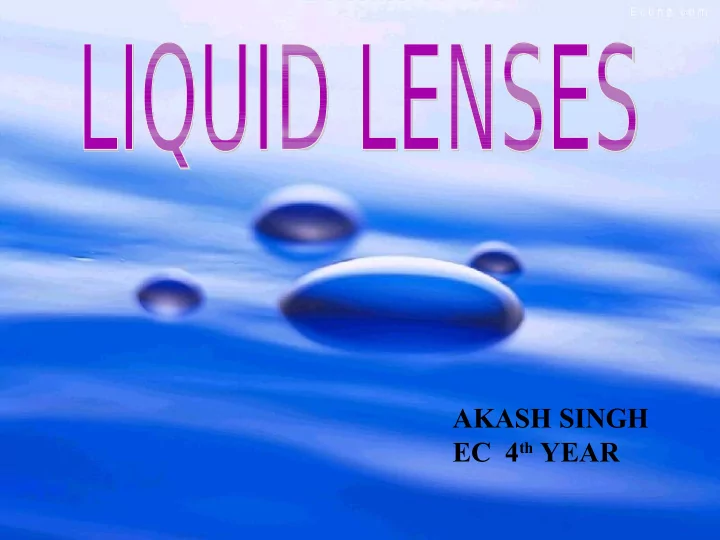

AKASH SINGH EC 4 th YEAR
LENS A lens may be defined as a piece of glass, plastic or any other transparent material which is curved on one or both sides and which makes a beam of light passing through it –bend, spread out, become narrower or change direction.
ZOOMING AND FOCUSING Zooming is a phenomenon exhibited by a photographic lens by virtue of which a lens can move in from a distant to a close view while keeping what is being photographed in focus . It is a method of adjusting the focal length i.e. the distance between the middle of the lens and the focus such that the image becomes more clear.
THE SIMPLEST DEFINITION OF A LIQUID LENS We've all been drinking a cold soda when the condensation on the side drips off. You may notice that whatever is under the water drop is magnified. That's a simple version of a liquid lens.
LIQUID LENS THAT IS USED IN VARIOUS ELECTRONIC DEVICES A liquid lens is a lens that uses the properties of two different liquids within a small space to provide magnification. Water and oil do not mix, and are both safe and inexpensive, so they are perfect for use in a liquid lens. The mixture of water and oil is sandwiched between two pieces of clear glass or plastic. In this way, a light, cheap liquid lens is created.
CONTD… Because water adheres to glass or plastic, it naturally forms a bubble shape This bubble shape within the liquid lens creates magnification and variable focus. The oil component of the liquid lens fills in the rest of the space to keep the water from sloshing around.
ELECTROWETTING • Water is a polar liquid. Thus its molecules can be attracted by an electric field. It is thus possible to change the shape of the liquid drop. • To carry out this process of electrowetting a water drop is deposited on a substrate made of metal, covered by a thin insulating layer. The voltage applied to the substrate modifies the contact angle of the liquid drop. The liquid lens uses two isodensity liquids, one is an insulator while the other is a conductor. The variation of voltage leads to a change of curvature of the liquid-liquid interface, which in turn leads to a change of the focal length of the lens.
DETAILED DESCRIPTION (CONSTRUCTIONAL Detail) To start with we take a glass tube which is coated with INDIUM TIN OXIDE (ITO). This is 50nm thin and acts as an electrode. Then we apply another coating of PARYLENE_NITROGEN which acts as an insulator between the electrode and water and this is 3µm thick. To force the water volume into a convex shape, we apply a top coat of a water- repelling FLUOROPOLYMER.
CONTD… We fill the tube with an insulator—a mixture of PHENYL METHYL SILOXANES that has the same density as water in order to make the curvature of the interface between the liquids perfectly spherical . When a voltage is applied between the water and the wall electrode, the polar water molecules are attracted toward the wall. The volume of the liquids is constant, so the curvature of their interface will change. If the liquids have different refractive indices, their interface acts as a variable-focus lens .
Why water? Water reduces the cost of manufacturing drastically. Water cannot be scratched and thus gives us a flawless lens . Water is more transparent to light than any other transparent material. Water is a polar solvent and hence it is subjected to electrowetting.
CONTD… A drop of water has a high surface tension and has a natural curvature similar to that of a conventional lens. Hence the lens obtained is a defect free lens.
Applications It has got an extensive use in cellular phones these days. It actually gives rise to a small system which can easily be embedded in a small device like that of a cellular phone. It is used in various electronics sets which integrate optics with them. For e.g. displays,cameras,computers.
CONTD… It is used in endoscope (in the field of medicines) which is developed on a number of optical functions. These days it is also used in tumor detection.
ADVANTAGES A liquid lens has got a large focal length range. One of its most important properties is its ruggedness i.e. it has got no moving parts. There is no problem of wear and tear as the lens does not have to change position. The time taken by it to respond is very less. It has got a speedy response of 2/100 th of a second. It has got a very good transparency in visible range.
CONTD… It has got a wide operating temperature range i.e. -50°c to 180°c . The cost of manufacturing is very less. It is very compact in size i.e. 10µm to 10mm. The curvature and the focal length of the liquid lens can be switched from concave to convex.
CONTD… Zoom lens can be created by combining two liquid lenses. Greatly reduces space taken up by conventional focus / zoom lens systems. Minimal power usage . The energy to drive the liquid lens is generated by charging the capacitor formed by the wall electrode and the water. Charging this approximately 100-pF capacitor requires less than a micro joule .
Physical Dimensions Diameter of lens : 10µm- 10mm Thickness of lens or enclosure : less than 1mm to 2mm.
Electrical Specifications Operating voltage (autofocus) : 1.5V Power not required in manual focusing mode.
Optical Specifications Magnification : 10x Focusing latency : 2 mm – infinity
DISADVANTAGES The only disadvantage of the liquid lens is the fact that it should not be subjected to temperature beyond the specified range or else water will freeze inside it and this may damage our system.
Proposed remedies The freezing point of the liquid can be improved by adding large quantities of salt (e.g., lithium chloride) or antifreeze (e.g., ethylene glycol).
Recommend
More recommend